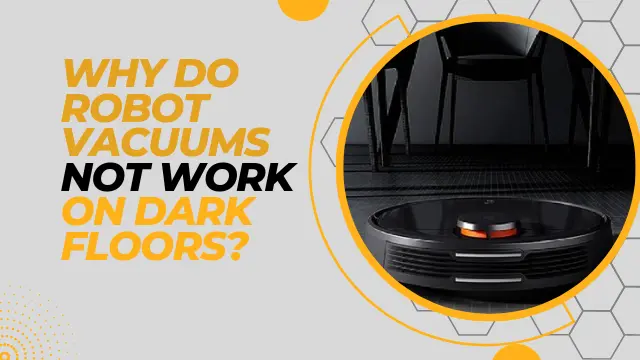Why do robot vacuums not work on dark floors? Although we know robot vacuums are equipped with a combination of sensors, cameras, and infrared technology to clean the designated area in a house. One common issue with dark floors is that they can absorb or reflect infrared light, which may interfere with the robot vacuum’s ability to detect the floor accurately. This can result in navigation problems or difficulty in identifying the floor surface.
However, there is nothing to worry about. Advancements in technology have led to improved sensors and mapping algorithms, and some robot vacuums now perform better on dark floors compared to earlier models.
Tip
Vacuums with Camera-based navigation can perform well on dark floors as they rely on visual information instead of solely relying on light reflection.
Why Do Robot Vacuums Not Work On Dark Floors?
Multiple factors hinder the efficiency of these high-tech devices like robo vacs. It also includes insufficient light in the room or non-standard floor types.

Due to the absence of adequate or excessive light (in the case of shiny glossy floors) in the room, your robot vacuum will find it hard to distinguish between dark-coloured floors and deep shadows. Also, your robot vacuum’s software or algorithms may need to be optimized for cleaning dark surfaces. Such surfaces can be more challenging for the robot vacuum to traverse.
What Glitches Can Robot Vacuum Face On Dark Floors?
Mapping Issues
Dark floors absorb or reflect infrared light, interfering with the robot vacuum’s sensors (misinterpreting reflections or shadows). This interruption is caused by visual illusions or patterns that confuse the robot vacuum’s navigation system. Eventually, creating an incorrect map of the environment and mapping issues arise. Vacuum mapping issues can be fixed, but right now we’ll now discuss what happens due to incorrect mapping.
What Happens Due To Incorrect Mapping?
Due to the reason mentioned above, the robot vacuum’s sensors may struggle to detect the edges or boundaries of dark-coloured carpets or rugs. When objects aren’t distinguished from the environment, it causes a vacuum to bump into stuff in the room, get stuck under furniture, and fall off of the cliffs. Other than sensors cleaning efficiency of the vacuum is also impacted on such floors.
Cleaning Efficiency Nose Dive
Due to the sensors’ inability, the robot vacuum’s brushes or suction system may not be as effective at cleaning dark-coloured carpets or rugs. Hence won’t be able to detect fine dust or debris, reducing its cleaning efficiency.
Battery Longevity Drops
The robot vacuum’s battery life may be shorter when cleaning dark floors, carpets and high-pile rugs due to increased sensor usage or navigation difficulties.
Conclusion
You have an upgraded model of a robot vacuum. Still, it needs to improve its efficiency in cleaning or working on some areas of your house. Now you have identified the culprit and want to know why robot vacuums do not work on dark floors. The reason is simple; you have an in-apt vacuum which isn’t designed to cope with glossy black floors.
It would help if you had a dedicated vacuum designed using fusion sensors or a Hybrid navigation system. Such vacuums are going to cover every nook of your house.
FAQs
Why Robot Vacuums Need Light?
Those vacuums that rely solely on camera-based navigation need adequate light in the room to see around. While other vacuums use laser-based navigation systems, they can even work in the dark.
Why Is The Battery Drained Quickly In The Dark Or On Black Floors?
No matter which technology-based vacuum you use, if sensors struggle to perform their job, they will need more power. Laser or IR-based vacuums confuse dark floors with shadows on black floors, and shadows are usually perceived as cliffs. Hence robots skip that floor area, and you might think there are some mapping issues.

Hi Everyone.
I’m Safeer. I always loved trying out the latest cleaning and home products and sharing my thoughts about those products with you awesome people. Whether it’s related to general cleaning or it includes cleaning with high-tech vacuum cleaners, I always test them myself and then share valuable opinions with you. Additionally, I also let you know how to resolve particular issues of vacuum cleaners. To look for detailed reviews and troubleshooting tips about vacuum cleaners VaccumCleanersMag is the perfect abode for you.